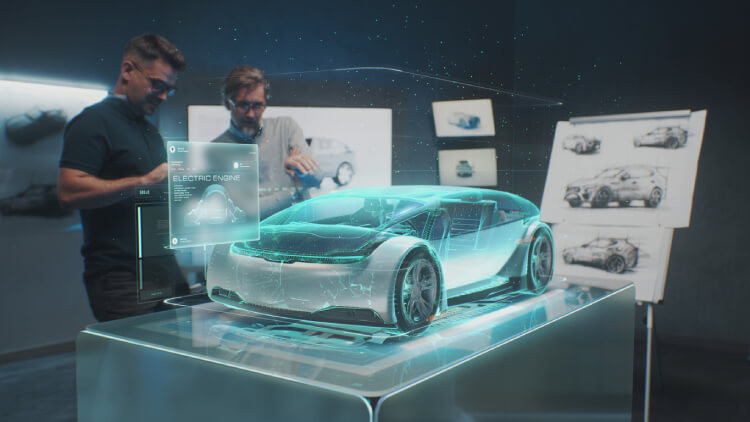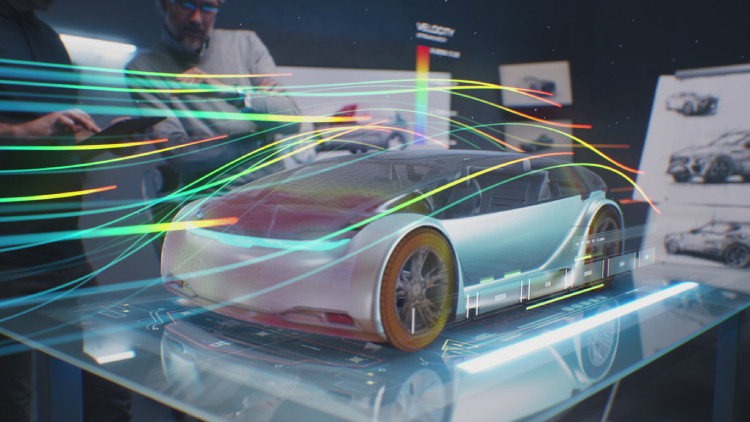AI in Car Design: What It Gets Right and Wrong
| 02-04-2025 | By Paul Whytock

Key Thing to Know:
- AI lacks self-doubt—humans don't, and that’s crucial. While AI excels at optimisation, human designers bring nuance, aesthetics, and empathy to car design decisions.
- AI is driving aerodynamic innovation and material discovery. It helps reduce vehicle weight, enhance range, and propose sustainable materials like hemp-based panels.
- Advanced AI is transforming battery technology. From molecule design to sodium-ion breakthroughs, AI is tackling EV cost, range, and performance challenges.
- AI is learning to personalise the driving experience. It adapts to user preferences, road conditions, and driving habits—though not all drivers may welcome this digital co-pilot.
Humans have a big advantage over AI, and this is called self-doubt. This may sound like a disadvantage, but it's not. It means humans have an understanding of knowing what they don't know. AI only knows what it knows.
More scientifically referred to as metacognition, it is the awareness, analysis and understanding of one's own thought processes and knowledge.
AI tends to be overconfident in decision-making because it has no self-doubt, and therefore, it needs an essential human touch when it comes to the design of cars. Why so?

Simple. Ask AI what is the most efficient aerodynamic shape for a forward-moving vehicle, and it will create a teardrop shape. And it would be right. This is a proven scientific fact. But a human car designer would doubt if any right-minded driver would want to own a car of that shape and would reject or, at the very least, modify it into something that a fellow human would be attracted to.

But having said all that, car designers of both aesthetic and technical aspects of automotive design are finding AI to be an invaluable work mate.
Creating the Slippery Car
AI is helping make cars more aerodynamic, and this is important in relation to electric vehicles (EVs) as it is a key factor in improving the efficient use of battery power and increasing the range of the vehicle, which is important when trying to gain consumer confidence.
Because of AI's ability to analysis vast quantities of data it can also have a substantial impact on the evaluation of possible new material for car manufacturers and also the material used in the production of batteries. With AI it is possible to reduce the weight of cars by up to 10% while simultaneously improving structural strength.
Some of the possible materials AI might suggest may seem extreme. For example, the use of hemp-based body panels could potentially create vehicles that are as strong and rigid as steel but far lighter and also kinder to the environment.
But whereas a car manufactured with a hemp body may sound ground-breaking, it isn't. In 1941 Henry Ford developed a prototype that was made of hemp and was seen as lightweight, strong and cost-effective.
In addition to those attributes, hemp can also be used to create ethanol fuel, which is made by fermenting the sugars and starches in hemp biomass. This produces a biofuel that can be used in the same way as petrol and is made from renewable resources and produces less emissions. This process has been known for several decades now.
Unfortunately, the use of hemp ethanol fuel has never come into widespread due to political and economic factors. The oil industry wasn't keen on the idea; surprise, surprise!
AI's influence on car design is growing. In the design phase, for example, AI is used to simulate comprehensive virtual crash tests. According to a study by the Fraunhofer Institute for Industrial Mathematics (ITWM)[1], using AI for crash test simulations can predict and improve the structural weaknesses of vehicles, reducing the number of prototypes needed.

It also impacts the way in which cars are manufactured and can make improvements in production processes. AI can constantly monitor what is happening during production processes. It is an untiring eye that will identify inaccuracies, incorrect assembly techniques by workers, and use of excessive materials and, in general, adds valuable input to the overall quality control process. According to the McKinsey Global Institute[2], AI could increase efficiency by 30% and improve overall reliability.
Advanced Battery Development
As already mentioned, a critical area AI can assist with is the development of better battery technologies that charge rapidly and store more energy.
A start-up called Aionics[3] in Palo Alto is using AI to accelerate breakthroughs in electrolytic materials for batteries by using generative AI programmes to design new molecules. This method is supported by software developed at Carnegie Mellon University.
The company employs large language models like GPT-4 for the preliminary stages of research. The AI used is fed a massive amount of data from chemistry and scientific papers, as well as research studies of previous materials, and then it goes on to track down and suggest potential molecule choices.
Aionics' philosophy is to create custom batteries so luxury cars can provide longer ranges and powerful performance, while cold-weather regions of the world focus on batteries that function well at low temperatures. In October 2023, the company announced a joint development partnership with the Cellforce Group, Porsche's wholly owned subsidiary focused on development of high-performance lithium-ion cells for automotive applications.
Battery Breakthrough
According to the Chartered Institute for IT[4], one of the latest breakthroughs in EV battery technology is from the PNNL-Microsoft collaboration, where researchers used a Microsoft Azure AI program to screen over 30 million materials for low-lithium batteries. They identified a new sodium variant. This material could cut lithium usage in EV batteries by up to 70% and help reduce EVs' price and environmental impact.
AI could also help with the emotive subject of battery operating range in terms of distance. Inaccurate range evaluation(RE) is one of the key areas that can deter the uptake of EVs and the cost of purchasing them. Traditional RE methods predict the EV's driving range based on past energy consumption and do not include in calculations influencing factors like road conditions or geography (an EV will go for longer on the flat plains of Aragon but be challenged when driving over the Pyrenees mountains), driving styles and climate conditions.
Currently, some EVs over-estimate range by around 48%, which does nothing for consumer confidence.
Transfer Learning Method
RE requires substantial data for accurate energy consumption and driving range prediction. This reality creates a challenge for new EV models with limited data from trips in real-world environments. One way to address this issue is by adopting a new transfer learning method. The idea behind this concept is to construct a predictive model for new EVs based on existing prediction models for popular EVs.
The IET (Institute of Engineering and Technology)[5] performed a study where the data included the battery state-of-charge (SoC) and the EV departure and arrival timestamp at rest areas during a trip. The IET feels this is an advantageous approach for easy, low-cost collection of AI training data. The study assumed the data of EV trips is collected through smartphones. When drivers stop at rest areas to charge their EVs, drivers input SoC into the smartphone application before and after charging.
At the same time, application of smartphone data collects GPS information of driver's position. If drivers stop at two rest areas to charge their EV, the data of EV trips from one rest area to the other using SoC, GPS, road and temperature information is collected.
This creates the data for an EV trip using trip distance, trip time, average speed, accumulation of up inclines, accumulation of down inclines, maximum battery capacity and temperature. From these factors, an RE is created from existing EVs.
How's the Driving Feeling?
We all know the feeling that when we buy a car not only do we want it to be reliable, good looking but we want to like driving it, like being inside it. In other words there is a very emotional aspect for most drivers when it comes to their car.
Now, AI experts say they can help car drivers achieve that euphoric motoring state. How come?

AI will absorb data that will allow it to learn how you like to your car to be, what interior temperature and atmosphere you like, how you respond to different road condition, what you do in a possible emergency situation and many other driving experiences.
For example, 0n-board sensors can detect road surface conditions. If for example road conditions become slippery AI will detect this and adjust braking and acceleration to ensure a safer journey. It will over time learn some of your driving preferences regarding long distance cruising speed preferences, the gap you prefer when following a vehicle and will adjust your vehicle speed to accommodate that.
AI can suggest adjustments to driving habits for more efficient fuel or battery usage. If it detects driving habits like rapid acceleration or harsh braking that consume more fuel it can remind drivers that a smoother driving style is easier on the environment and also the driver's wallet.
Just how much of this advice or, as some would say, interference a driver would like is debatable. Some may welcome it, but others may adopt an attitude of, 'It's my car, and I'm in charge", and start looking to see how to disable the interfering software thing that's spoiling his driving experience.
But, as AI is so smart at recognising driver attitudes, will it spot that mood and switch itself off? Maybe. Perhaps when it develops a modicum of self-doubt!
References
- Fraunhofer Institute for Industrial Mathematics: https://www.itwm.fraunhofer.de/en.html
- McKinsey Global Institute: https://www.mckinsey.com/mgi/overview
- Aionics: https://aionics.io
- Chartered Institute for IT: https://www.bcs.org
- The IET (Institute of Engineering and Technology): https://ietresearch.onlinelibrary.wiley.com

